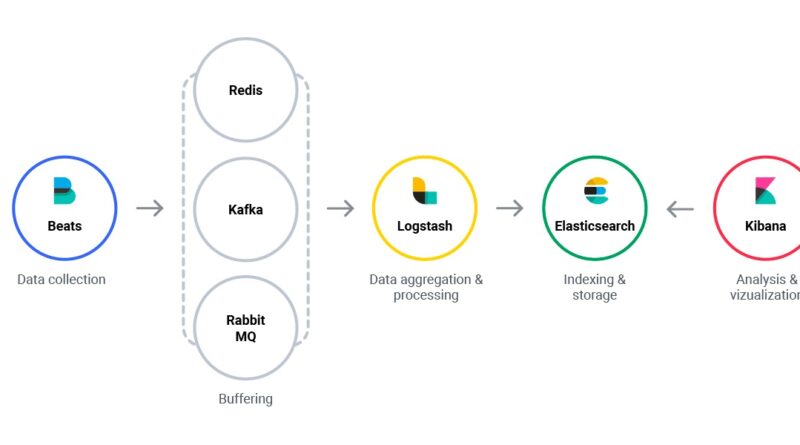Harnessing the Power of Data Analytics with ELK Stack
Data analytics has become a cornerstone of modern decision-making, enabling organizations to extract valuable insights from their vast datasets. In this context, the ELK Stack—Elasticsearch, Logstash, and Kibana—emerges as a powerful tool for managing and analyzing data efficiently. Whether you’re a data science professional or someone exploring a data analyst course or data analytics course in Mumbai, understanding how the ELK Stack operates can significantly boost your analytical skills and career prospects.
What is the ELK Stack?
The ELK Stack is an open-source framework designed for managing, searching, and visualizing large amounts of data. Each component of this stack plays a specific role:
- Elasticsearch: This search engine enables fast and scalable data indexing and querying.
- Logstash: A data processing pipeline that collects, processes, and sends data to Elasticsearch.
- Kibana: A visualization tool for analyzing data through graphs, charts, and dashboards.
By combining these three tools, organizations can process and analyze data in real time, enabling quicker decisions and deeper insights. The ELK Stack is widely used in e-commerce, IT, healthcare, and finance industries.
Why Use ELK Stack for Data Analytics?
Traditional analytics tools often need help to handle large datasets or offer real-time insights. The ELK Stack addresses these challenges by offering:
- Scalability: Elasticsearch is built for scalability and can handle billions of documents while maintaining query speed.
- Flexibility: Logstash can collect data from various sources and in multiple formats, making it adaptable to diverse business needs.
- Ease of Visualization: Kibana’s customizable dashboards and reporting features simplify the process of turning raw data into actionable insights.
- Cost Efficiency: As an open-source solution, the ELK Stack eliminates licensing costs while offering enterprise-grade functionality.
Learning the ELK Stack can be a game-changer for individuals pursuing a data science course in Mumbai. It equips you with the tools to manage and interpret data effectively in real-world scenarios.
Key Features of ELK Stack Components
Elasticsearch: The Core of the Stack
Elasticsearch is at the heart of the ELK Stack. It offers distributed search capabilities, enabling users to query data quickly and efficiently. Its key features include:
- Indexing: Elasticsearch structures data into indices for better organization and faster retrieval.
- Full-Text Search: Advanced search capabilities allow users to retrieve specific information from extensive datasets.
- Clustering: Elasticsearch supports horizontal scaling through clustering, ensuring high availability and fault tolerance.
Logstash: The Data Processing Engine
Logstash is the intermediary that collects and processes data before feeding it to Elasticsearch. Some of its standout features are:
- Data Parsing: Logstash supports various input sources, from log files to databases.
- Filtering: Users can transform data to meet specific needs, making it cleaner and more structured.
- Integration: Logstash integrates seamlessly with other systems, including cloud platforms and third-party tools.
Kibana: Insights at a Glance
Kibana is where data turns into insights. Its intuitive interface and rich visualizations make it an essential tool for analysts. Key aspects include:
- Custom Dashboards: Users can create dashboards tailored to their specific business requirements.
- Real-Time Analysis: Kibana supports live data feeds, enabling organizations to act on emerging trends.
- Ease of Sharing: Reports and visualizations can be easily shared across teams for collaborative decision-making.
Real-World Applications of ELK Stack
The ELK Stack’s versatility makes it invaluable across various industries:
- E-commerce: Retailers use it to track customer behavior, monitor inventory, and optimize supply chains.
- Healthcare: ELK helps analyze patient data for better outcomes and efficient resource allocation.
- IT Operations: Teams rely on ELK for log management, error tracking, and performance monitoring.
- Banking and Finance: Fraud detection and compliance reporting become more manageable with the ELK Stack.
Gaining hands-on experience with these applications can make professionals or students enrolled in a data science course in Mumbai highly competitive in the job market.
Implementing ELK Stack: A Step-by-Step Guide
1. Install and Configure Elasticsearch
Start by downloading and installing Elasticsearch on your system. Configure its settings to suit your requirements, such as setting up nodes and clusters for scalability.
2. Set Up Logstash
Install Logstash and configure it to collect data from your chosen sources. Use filters to parse and transform the data as needed.
3. Deploy Kibana
Install Kibana and link it to your Elasticsearch instance. Customize your dashboards and set up visualizations that align with your objectives.
4. Test and Optimize
Run sample queries and test your visualizations to ensure everything is functioning correctly. Optimize settings to improve performance and handle larger datasets.
5. Integrate with Other Tools
Integrate the ELK Stack with other systems or cloud platforms to enhance its functionality and expand its use cases.
Learning ELK Stack for Career Growth
As data-driven decision-making becomes the norm, professionals with ELK Stack expertise are in high demand. A solid understanding of this toolset can open doors to roles like data analyst, systems engineer, and data visualization specialist. If you’re considering a data analyst course, , ensure it includes modules on ELK Stack to make you job-ready for today’s competitive market.
Challenges and How to Overcome Them
While the ELK Stack offers numerous advantages, it does come with specific challenges:
- Learning Curve: The technical aspects of setting up and configuring ELK components can be daunting for beginners.
- Solution: Start with basic tutorials and online resources, or enroll in a structured learning course.
- Resource Usage: Elasticsearch and Kibana can be resource-intensive, especially for smaller organizations.
- Solution: Optimize configurations and consider deploying on cloud platforms for scalability.
- Data Security: As an open-source platform, the ELK Stack requires additional measures to secure sensitive data.
- Solution: Implement encryption, access controls, and monitoring to safeguard your data.
By addressing these challenges, you can maximize the potential of the ELK Stack in your data analytics journey.
Conclusion
The ELK Stack is a robust and versatile solution for modern data analytics needs.It lets enterprises to better organize, analyze, and display data, allowing them to make more informed choices. Mastering the ELK Stack is an invaluable step for those interested in advancing their careers through a data analyst course or data analytics course in Mumbai. It enhances your technical skills and equips you to tackle real-world challenges in data-driven roles.
With the proper knowledge and hands-on practice, the ELK Stack can be a transformative tool for harnessing the power of data analytics.
Business Name: Data Science, Data Analyst and Business Analyst Course in Mumbai
Address: 1304, 13th floor, A wing, Dev Corpora, Cadbury junction, Eastern Express Highway, Thane, Mumbai, Maharashtra 400601 Phone: 095132 58922




